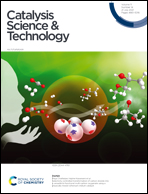Inhibition of hydrogen evolution without debilitating electrochemical CO2 reduction via the local suppression of proton concentration and blocking of step-edges by pyridine functionalization on Cu electrocatalysts†
Abstract
Electrochemical carbon dioxide reduction reaction (CO2RR) into chemicals can store renewable electricity and simultaneously control global warming. Albeit inexpensive copper electro-catalyzes CO2 to hydrocarbons at reasonable rates, it suffers from low selectivity due to high hydrogen evolution reaction (HER) activity. Although an increase in bulk pH suppresses HER activity, this leads to a CO2 reaction with hydroxide and the formation of bicarbonate and carbonate ions. In contrast, we demonstrate selective HER suppression by functionalizing Cu electrocatalysts with pyridine molecules without a commensurate reduction in CO2RR activity. Density functional theory (DFT) based computational results suggest that the decrement in the H binding energy and blockage of step edge atoms (which are the most active sites for the HER) by pyridine molecules are the reasons for selective suppression of the HER activity on the copper surface after pyridine functionalization. Further, an insignificant decrease in CO binding is the reason behind the lack of suppression of the CO2RR activity. This study provides pointers towards better electrocatalyst design for the CO2RR.



 Please wait while we load your content...
Please wait while we load your content...